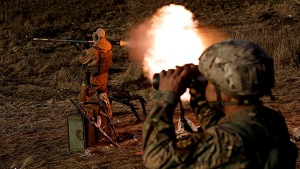What to Know about the Western Tanks Heading to Ukraine

The United States and Germany are sending their best tanks to Ukraine. Here’s why that matters.
After months of diplomatic deliberations between Western allies, Germany and the United States announced on January 25 that they would send a total of 45 of their best tanks to Ukraine. Not too long ago, the provision of Germany’s Leopard 2 tanks and the US’s M1 Abrams tanks seemed unlikely, but officials argue that the battlefield has since changed, and Russia’s nuclear threats seem less likely.
US President Joe Biden stated that the 31 Abrams tanks—the equivalent of one Ukrainian battalion—will enable Ukraine to better defend its territory and “achieve its strategic objectives.” Those objectives include a spring offensive against invading Russian forces, whose tanks greatly outgun the old Soviet-era tanks Ukraine relies on now.
Germany’s Concerns
Part of the push for the Abrams tanks came from Germany’s chancellor, Olaf Schultz, who insisted that he would only let Europe’s Leopards out of the cage if America sent its best. Berlin’s residual pacifist sentiment from the Cold War and its shared history with Russia from that era make this a sensitive topic for Germans. Although public opinion has shifted further in favor of supporting Ukraine in recent weeks, Schultz privately raised concerns about the optics of German tanks rolling across Europe toward a war. Ultimately, Biden’s reluctant agreement to provide US tanks gave Scholtz the political cover he needed to assuage any concerns from the German public.
The Leopard 2 vs. The M1 Abrams
The United States’ and Germany’s decision came a few weeks after the United Kingdom announced it would send 14 of its Challenger 2 tanks. Germany’s move allowed Poland, Finland, Norway, and Spain to provide tanks as well. Some of those tanks are older variations of the Leopard 2, with different capabilities, ammunition, targeting systems, and maintenance requirements.
Of the 2,000 Leopards on the European continent, hundreds can be made available sooner than the Abrams. For some, the US provision of Abrams tanks is less about their capabilities than simply persuading Germany to make a move.
Although the Leopard 2 and Abrams are larger and more capable than the Russian equivalent, they require very different materials and training to deploy on the battlefield. The Leopard 2 is lighter, more agile, and better suited to conduct an offensive in the flatter plains of the Donbas or further south from Kherson.
The American tank comes with its own challenges. Though it is considered the most sophisticated tank in the world, Pentagon officials argue that the Abrams isn’t the best near-term option. It requires jet fuel, which is harder to supply and would require a different logistics chain than the diesel fuel that powers the other tanks.
For some, the tanks represent the West’s unwavering commitment to Ukraine, in contradiction to Putin’s belief that NATO would fracture in the face of gas and oil cutoffs and Russian cyberattacks. On the other hand, critics feel that the United States and Germany took too long to approve the transfer and missed a window of peak Russian vulnerability. While neither tank will be immediately deployed on the battlefield, the Leopards could make it to Ukraine in a few months, whereas the Abrams may take a year or longer. Each tank system requires separate operation and maintenance training as well.
Throughout the war, Ukrainian forces have proven to be fast learners with other weapons systems. These logistical issues underscore the difficulty of an emergency delivery, but Western officials insist that they are going to make it work and that the tanks will have a significant operational impact. The question is whether that impact will be soon enough to make a difference.


Related Content
 US Foreign Policy
US Foreign Policy
"Tanks alone will not be enough for Ukraine to win the war. But if used properly, they are still a vital component of modern warfare," Paul Poast writes.
 Public Opinion
Public Opinion
Nearly half of Americans (47%) now say Washington should urge Kyiv to settle for peace as soon as possible.
 US Foreign Policy
US Foreign Policy
"The West needs to contemplate a world in which the conflict continues with neither victory nor peace in sight," Ivo Daalder and James Goldgeier write.
